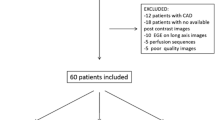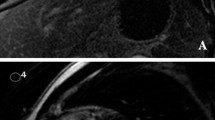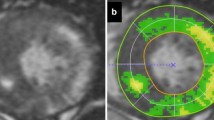Abstract
Our aim was to compare the frequency and distribution of late gadolinium enhancement (LGE) on contrast MRI between hypertrophic cardiomyopathy (HCM) patients with apical hypertrophic cardiomyopathy (APH) and those with asymmetrical septal hypertrophy (ASH). We studied 66 patients with HCM (50 men and 16 women; average age: 58.8 ± 29.8 years) who had undergone MRI. All the MRI examinations were performed using a 1.5 T system. LGE images were acquired using the inversion recovery segmented spoiled-gradient echo and phase-sensitive inversion recovery methods. We evaluated 17 segments of the left ventricle as defined by the American Heart Association criteria for LGE determination. LGE was detected at the junction of the right ventricle and the interventricular septum in 25 (73.5%) of the 34 HCM patients with ASH and in the apex of the heart in 13 (40.6%) of the 32 patients with APH. LGE-positive areas were more widely distributed in the case of the ASH group than in the case of the APH group. The distribution of LGE was clearly different between the two groups (Fisher’s exact probability test, P = 0.0068). The number of LGE-positive cases and LGE-positive segments were significantly higher in the ASH group than in the APH group and there was a significant difference in the distribution of the LGE-positive areas between the two groups. LGE was mainly detected in the hypertrophied areas of the myocardium.





Similar content being viewed by others
References
Richardson P, McKenna W, Bristow M et al (1996) Report of the 1995 World Health Organization/International Society and Federation of Cardiology task force on the definition and classification of cardiomyopathies. Circulation 93(5):841–842
Maron BJ, Wolfson JK, Ciró E et al (1983) Relation of electrocardiographic abnormalities and patterns of left ventricular hypertrophy identified by 2-dimensional echocardiography in patients with hypertrophic cardiomyopathy. Am J Cardiol 51(1):189–194. doi:10.1016/S0002-9149(83)80034-4
Sakamoto T (2001) Apical hypertrophic cardiomyopathy (apical hypertrophy): an overview. J Cardiol 37(Suppl. 1):161–178
Eriksson MJ, Sonnenberg B, Woo A et al (2002) Long-term outcome in patients with apical hypertrophic cardiomyopathy. J Am Coll Cardiol 39(4):638–645. doi:10.1016/S0735-1097(01)01778-8
Zenovich AG, Lesser JR, Casey SA et al (2004) Images in cardiovascular medicine. Hypertrophic cardiomyopathy with apical aneurysm. Circulation 110(16):e450. doi:10.1161/01.CIR.0000145174.74063.C1
Sato A, Shiga T, Kawarai H et al (2003) Apical hypertrophic cardiomyopathy with aneurysmal degeneration of the apex. Heart Vessels 18(1):53–54. doi:10.1007/s003800300010
Suzuki J, Shimamoto R, Nishikawa J et al (1999) Morphological onset and early diagnosis in apical hypertrophic cardiomyopathy: a long term analysis with nuclear magnetic resonance imaging. J Am Coll Cardiol 33(1):146–151. doi:10.1016/S0735-1097(98)00527-0
Moon JC, Fisher NG, McKenna WJ et al (2004) Detection of apical hypertrophic cardiomyopathy by cardiovascular magnetic resonance in patients with non-diagnostic echocardiography. Heart 90(6):645–649. doi:10.1136/hrt.2003.014969
Budoff MJ, Cohen MC, Garcia MJ et al (2005) ACCF/AHA clinical competence statement on cardiac imaging with computed tomography and magnetic resonance: a report of the American College of Cardiology Foundation/American Heart Association/American College of Physicians Task Force on Clinical Competence and Training. J Am Coll Cardiol 46(2):383–402. doi:10.1016/j.jacc.2005.04.033
Kim RJ, Fieno DS, Parrish TB et al (1999) Relationship of MRI delayed contrast enhancement to irreversible injury, infarct age, and contractile function. Circulation 100(19):1992–2002
Kim RJ, Wu E, Rafael A et al (2000) The use of contrast-enhanced magnetic resonance imaging to identify reversible myocardial dysfunction. N Engl J Med 343(20):1445–1453. doi:10.1056/NEJM200011163432003
Choudhury L, Mahrholdt H, Wagner A et al (2002) Myocardial scarring in asymptomatic or mildly symptomatic patients with hypertrophic cardiomyopathy. J Am Coll Cardiol 40(12):2156–2164. doi:10.1016/S0735-1097(02)02602-5
Moon JC, McKenna WJ, McCrohon JA et al (2003) Toward clinical risk assessment in hypertrophy cardiomyopathy with gadolinium cardiovascular magnetic resonance. J Am Coll Cardiol 41(9):1561–1567. doi:10.1016/S0735-1097(03)00189-X
Teraoka K, Hirano M, Ookubo H et al (2004) Delayed contrast enhancement of MRI in hypertrophy cardiomyopathy. Magn Reson Imaging 22(2):155–161. doi:10.1016/j.mri.2003.08.009
Maron BJ, Tholakanahalli VN, Zenovich AG et al (2004) Usefulness of B-type natriuretic peptide assay in the assessment of symptomatic state in hypertrophic cardiomyopathy. Circulation 109(8):984–989. doi:10.1161/01.CIR.0000117098.75727.D8
Cerqueira MD, Weissman NJ, Dilsizian V et al (2002) Standardized myocardial segmentation and nomenclature for tomographic imaging of the heart: a statement for healthcare professionals from the Cardiac Imaging Committee of the Council on Clinical Cardiology of the American Heart Association. Circulation 105(4):539–542. doi:10.1161/hc0402.102975
Wigle ED (2001) Cardiomyopathy: the diagnosis of hypertrophic cardiomyopathy. Heart 86(6):709–714. doi:10.1136/heart.86.6.709
Moon JC, Reed E, Sheppard MN et al (2004) The histologic basis of late gadolinium enhancement cardiovascular magnetic resonance in hypertrophic cardiomyopathy. J Am Coll Cardiol 43(12):2260–2264. doi:10.1016/j.jacc.2004.03.035
Gebker R, Neuss M, Paetsch I et al (2006) Images in cardiovascular medicine. Progressive myocardial fibrosis in a patient with apical hypertrophic cardiomyopathy detected by cardiovascular magnetic resonance. Circulation 114(5):e75–e76. doi:10.1161/CIRCULATIONAHA.106.612994
Author information
Authors and Affiliations
Corresponding author
Rights and permissions
About this article
Cite this article
Yamada, M., Teraoka, K., Kawade, M. et al. Frequency and distribution of late gadolinium enhancement in magnetic resonance imaging of patients with apical hypertrophic cardiomyopathy and patients with asymmetrical hypertrophic cardiomyopathy: a comparative study. Int J Cardiovasc Imaging 25 (Suppl 1), 131–138 (2009). https://doi.org/10.1007/s10554-008-9406-1
Received:
Accepted:
Published:
Issue Date:
DOI: https://doi.org/10.1007/s10554-008-9406-1




